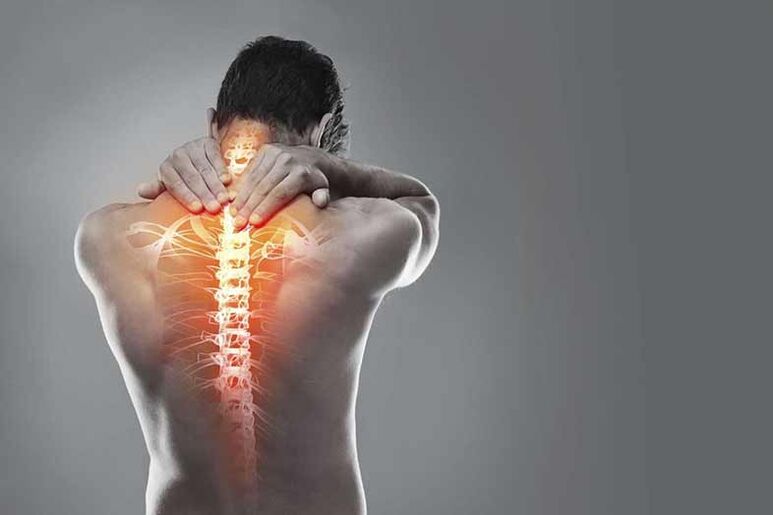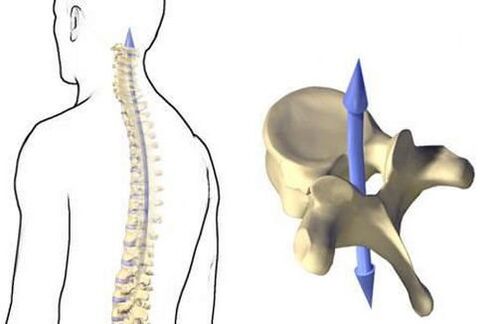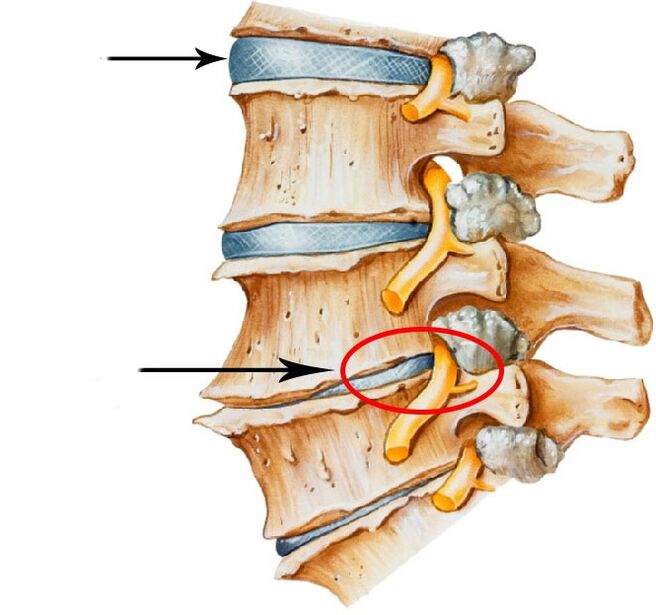
According to statistics, almost half of people aged 30-55 are suffering from osteochondrosis.The lower age threshold of the disease has fallen to 18 years in recent years.
What is osteochandrosis
The spine osteochondrosisThis is expressed in the defeat of the intervertebral disc, which loses its elasticity, elasticity, and cracks.
Cervix osteochondrosisIt involves damage to the plates in the cervix.
How does the spine work
If the essence is slightly simplified for better understanding, the spine device can be described as follows.
The spine consists of a separate, similarly to each other, above each other.
Despite the fact that there is some difference in the form, all the vertebrae has a common structure.Each vertebra has a hole - all holes are above the other and forms a vertical canal (tunnel) that passes through the entire spine.
The spinal cord passes through the spinal canal.It passes vertically through the holes of each vertebrae, and its roots (branches in which sensitive nerve endings) leave the channel between the pair of each vertebrae.This is possible because the vertebrae do not lose each other and are not tightly secured, and the vertebrae of each vertebrae is cartilage - a vertebrae plate.

The wheels and the leagues combine the vertebrae and play the role of the shock absorber.Because of their flexible structure, they are flexibly compressed in the movement and inclination of the body (from the side of the inclination) or when evacuation (straightened).Thus, the plates provide elasticity to the spine and soften it from vertical pressure to every spinal column of the spinal column, as well as vertical vibrations upwards, which turn up or run.After all, man is a unique, erect and clear being.
Such a work of the spine can be ensured if the full load is properly distributed.Nature is incredibly stable, hard and at the same time flexible.
And if not?
If the shape of the spine, formulated by nature, is for some reason breaking (bending, excessive bends on the lower back, skoliosis, flat legs), or a constant chronic habit of sitting, lying, standing, vertebral compounds begin to wear out, losing their elasticity.They are pulled out to the pages, forming hernia.
The abrasion of intervertebral plates - there is a person who counts the line.After all, only people have a vertical load in humans.Such vertical clamping throughout the spinal components (especially in overweight people) leads to a gradual deterioration of blood supply to the intervertebral discs (the vascular direction is restricted) - the disc loses durability and strength.
What is next?

The disk hernia is pressedBlood vesselsToNervous rootsand sometimesspinal cordOr
The consequences of osteochondrosis of the cervix
Due to changes in the anatomical proportions of the spine, blood vessels (main arteries and veins) are destroyed.
What happens:Due to changes in the anatomical proportions of the spine, blood vessels (main arteries and veins) are destroyed.What leads:
- Blood flow to the brain and violation of the brain's total nutrition.
- Venous outflow violation and toxic substances accumulation in the brain tissues.
How does it manifest itself in itself:
- Dizziness (up to short -term loss of consciousness).
- Headache.
- Visual impairment.The smell, the flavor violation.
- Swallowing, pronunciation, general violation and speech difficulties and difficulties in speech breathing.
- Cognitive disorders: impaired memory, perception, complexity with the concentration of attention, complexity with logical thinking.Violation of reading.
- Missing.Inappropriate.A reduction in disorder.Forgetfulness.
- Difficulties with pronunciation of complex and long words, complex grammatical constructions.
- Reducing performance, overtime.
- Infringements in the emotional and personal sphere: sharp and unreasonable mood fluctuations, emotional incontinence, irritability, anger.
Diagnosis: Cognitive disorders, Afasia, bulbar dysarthria, diskiropathy, vertebro-baslar insufficiency (VBN), etc.Diagnosed. Medication in these cases:
- Vascular drugs.They have an extremely low evidence base.They need to use the doctor and can cause a variety of complications and side effects under the doctor's control.
- Nootropic drugs.The appointment should be strictly used under the control of the doctor.Many people have quite serious contraindications from the cardiovascular system (with hidden heart pathology and serious negative consequences).Most nootropes do not have a positive pharmacological result, ie useless.
- Soothing drugs, including sedatives, antidepressants, barbiturates, bromides.Psychotropic drugs.The appointment should be strictly used under the control of the doctor.They can be addictive and have multiple side effects (dizziness, headache, visual impairment and urination, dry mouth, nausea, etc. shameful disorders, decrease in libido, sleep disorders, body weight set).
There is a nerve roots - nerves from the spinal cord and upper body tissues, nerves - nerves from spinal cord.
What happens:
There is a nerve roots - nerves from the spinal cord and upper body tissues, nerves - nerves from spinal cord.
What leads: In an outstanding pain syndrome, often chronic, repetitive.
How does it manifest itself in itself:
- Pain in the neck, the back of the head (turning the head or at rest, shots or chronic).
- Headache (tension headache is associated with the tension of the back surface of the neck and the head of the head - pain, often poured over the head, often with noise and ringing of the ears, flies in the eyes).
- Pain in the upper part of the chest.
- Pains that simulate heart pain in the lungs.
- Pain in the upper part of the shoulders, shoulders.
- Pain in the shoulder joint or in the whole hand.
- The numbness of the fingers, hands, hands is completely.
Medication in these cases:
- Non-steroidal anti-inflammatory drugs (analgesics, antipyretic) that are strictly required to appoint a doctor and check the doctor and have side negative reactions from the gastrointestinal tract (gastritis, ulcers, ulcerative bleeding), cardiovascular system, kidneys.
- Preparations that alleviate muscle hypertension and are strictly for deliberate purposes and are under the control of the doctor and have side negative reactions in the form of strong dizziness, weakness, to completely exhaustive.
The most common exercise of medication is the treatment of osteochondrosis.However, this is symptomatic treatment.Medicines are used to stop inflammatory processes and pain (sometimes need to turn to novocaine blockade), a reduction in neurological and psycho -emotic symptoms.The most important thing is that pharmacological therapy is under strict supervision.
However, if you do not stop the process of vessels directly, do not restore the balance of the spine and all related structures that are formed by nature (violation of body symmetry, flat legs, muscle cramps that occur as a compensation reaction), the disease will not work and do not help and do not need to help and do not need to help and do not needHelp and do not need to help and do not need to help and do not need to help and do not need to help.
The purpose of osteopathic treatment is to eliminate the above causes of osteochondrosis, which is considered to be the most effective today.
Treatment of osteochandrosis osteoporosis
Rule 1: "The earlier, the better" for osteochondrosis, it works especially!After all, healing of osteochondrosis - means that it does not quench the pain or other syndrome, but to restore normal spine, to ensure the intervertebral plate with complete nutrition (to refund the normal blood supply) even before degenerative processes before degenerative processes.
Osteopath defines the place where the displacement or deformation has occurredThe reasons why the vessels of the spine have been made- Osteopathy considers the body as a single system in which everything is connected and touches each other, literally pulling it in succession.This means that osteopath restores the work of all structures in which the changes in the chain have violated the power of the intervertebral plate.The task of osteopath is to restore the equilibrium ratio of organs and tissues, and to eliminate total nutritional tensions and clamps.And if, in the case of a neglected condition of the disease, changes in the spine structure result in a violation of the work of the internal organs, the purpose of osteopathic treatment is to eliminate emerging dysfunctions.
That is, osteopath works with the root cause of the disease, not the syndromes, including the pain.Although he begins his work, with the pain relief.However, this does not stop here.The best way to osteopathy is physiotherapy (ensures reduction in pain and inflammatory processes) and physiotherapy exercises - exercise therapy (strengthens the muscle linen, helps the body to remain new but appropriate).
Conclusions
- The neck cannot be handled easily.Because the brain should be provided with unobstructed nutrition.And it depends on how healthy the "conductor" is.
- You can't wait.The more the disease starts, the harder it is to pull back (and sometimes impossible).Osteopath is able to determine the disease when it is still rudimen and does not manifest itself in any way.Never ignore the diagnostic test.
- It is impossible to neglect the prevention of osteochondrosis.It is always easier than treating the disease.

























